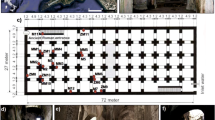Abstract
Structural studies to assess the earthquake resistance of Byzantine monuments have proved that their static and dynamic behaviour depend on the mechanical, chemical and microstructural properties of the masonry mortars and bricks. The crushed brick/lime concrete is classified as an advanced cement-based composite, explaining the longevity of Byzantine monuments. More specifically, the Byzantine monument of the Church of St. Michaels in Vydubytskyi Monastery (11th c.), in Kiev has been studied to provide insights on its effective dynamic properties, during major earthquake in the area. The bricks and mortars are investigated taking under consideration the construction technique known as “concealed course”, by optical microscopy (OM), scanning electron microscopy (SEM), transmission electron microscopy (TEM), X-ray diffraction (XRD) and thermal analysis (TG-DTA). They were found to allow for continuous stresses and strains due to the presence of the amorphous hydraulic formations (CSH) at the crushed-brick powder/binder interfaces and in the binding matrix, and be able to absorb greater energy without initiations of fractures. The interpretation of the amorphous nature of the hydraulic formations is compared with the use of fine siliceous sources to accelerate the formation of hydraulic compounds. The determination of the mortar properties indicated that they are of considerable mechanical strength and durability. The results show major similarities with these of the Byzantine monuments in Istanbul (Theodosian Walls and Hagia Sophia - 6th - 11th c.), giving evidence to earthquake resistant construction techniques and materials. Hence, a reverse engineering approach, complying with the deduced criteria is proposed in order to reproduce compatible restoration concrete for earthquake protection of monuments.
Access this chapter
Tax calculation will be finalised at checkout
Purchases are for personal use only
Preview
Unable to display preview. Download preview PDF.
Similar content being viewed by others
References
A. S. Cakmak, M. Erdik, and A. Moropoulou, A joint program for the protection of the Justinian Hagia Sophia, Proc. Fourth Int. Symp. on the Conservation of Monuments in the Mediterranean Basin, Rhodes, 4, (1997).
A. Bakolas, G. Biscontin, and E. Zendri, Characterization of mortars from traditional buildings in seismic areas, PACT Revue du groupe europeen d’etudes pour les techniques physiques, chimiques, biologiques et mathematiques appliquees a l’archcologie 56 17–29 (1998).
E. Durukal, A. S. Cakmak, O. Yuzugullu, and M. Erdik, Assessment of the earthquake performance of Hagia Sophia, PACT Revue du groupe europeen d’etudes pour les techniques physiques, chimiques, biologiques et mathematiques appliquees a l’archeologie 56 49–57 (1998).
A. S. Cakmak, A. Moropoulou, and C. A. Mullen, Interdisciplinary study of dynamic behaviour and earthquake response of Hagia Sophia, Soil Dyn. Earthquake Engng 14 (9) 125–133 (1995).
A. Moropoulou, A. S. Cakmak, and G. Biscontin, Crushed brick lime mortars of Justinian’s Hagia Sophia, in: Materials issues in art and archaeology V, edited by Vandiver PB, Druzik JR, Merkel JF, Stewart J, 462 (MRS, 1997).
A. Moropoulou, A. S. Cakmak, and N. Lohvyn, Earthquake resistant construction techniques and materials on Byzantine monuments in Kiev, Soil Dynamics and Earthquake Engineering 19, 603–615 (2000).
A. Moropoulou, A. Bakolas, and S. Anagnostopoulou, Composite materials in ancient structures, Cement and Concrete Composites 27, 295–300 (2005).
P. Touliatos, The historic construction as a complete structural system, its decay in time and compatible restoration interventions, Proc. of the INCOMARECH Conf., Athens, (1998).
A. Moropoulou, A. Bakolas, and K. Bisbikou, Characterization of ancient, Byzantine and later historic mortars by thermal analysis and X-ray diffraction techniques, Thermochim Acta 269/270, 779–795 (1995).
J. E. Adams, and A. W. Kneller, Thermal analysis of medieval mortars from gothic cathedrals in France, Engineering geology of ancient works Engineering Geology of Ancient Works, Balkema, Rotterdam 1019–1026 (1988).
A. R. Livingston, E. P. Stuzman, R. Mark, and M. Erdik, Preliminary analysis of the masonry of Hagia Sophia Basilica, Materials issues in art and archaeology III. Mat Res Soc, Pittsburgh, 721–736 (1992).
E. S. Katsaragakis, A new tensile test for concrete Mater Struct 20, 120–125 (1987).
Th. Tassios, C. Vachliotis, and C. Spanos, In situ strength measurements of masonry mortars, Proc Int. Conf. on Repair and Strengthening of Stone Masonries, ICCROM, Athens, 53–61 (1989).
A. Moropoulou, A. Bakolas, and K. Bisbikou, Physico-chemical adhesion and cohesion bonds in joint mortars imparting durability to the historic structures, Construction and Building Materials 14, 35–46 (2000).
A. Moropoulou, A. S. Cakmak, G. Biscontin, A. Bakolas, and E. Zendri, Advanced Byzantine cement based composies resisting earthquake stresses: the crushed brick / lime mortars of Justinian’s Hagia Sophia, Construction and Building Materials 20 (8), 543–552 (2002).
I. G. Richardson, The nature of the hydration products in hardened cement pastes, Cem Concr Comp 22, 97–113 (2000).
A. Moropoulou, A. S. Cakmak, K. C. Labropoulos, R. Van Grieken, and K. Torfs, Accelerated microstructural evolution of a calcium-silicate-hydrate (C-S-H) phase in pozzolanic pastes using fine siliceous sources: Comparison with historic pozzolanic mortars, Cement and Concrete Research 34, 1–6 (2004).
Author information
Authors and Affiliations
Editor information
Editors and Affiliations
Rights and permissions
Copyright information
© 2006 Springer
About this paper
Cite this paper
Moropoulou, A., Labropoulos, K., Moundoulas, P., Bakolas, A. (2006). THE CONTRIBUTION OF HISTORIC MORTARS ON THE EARTHQUAKE RESISTANCE OF BYZANTINE MONUMENTS. In: KONSTA-GDOUTOS, M.S. (eds) Measuring, Monitoring and Modeling Concrete Properties. Springer, Dordrecht. https://doi.org/10.1007/978-1-4020-5104-3_78
Download citation
DOI: https://doi.org/10.1007/978-1-4020-5104-3_78
Publisher Name: Springer, Dordrecht
Print ISBN: 978-1-4020-5103-6
Online ISBN: 978-1-4020-5104-3
eBook Packages: EngineeringEngineering (R0)




